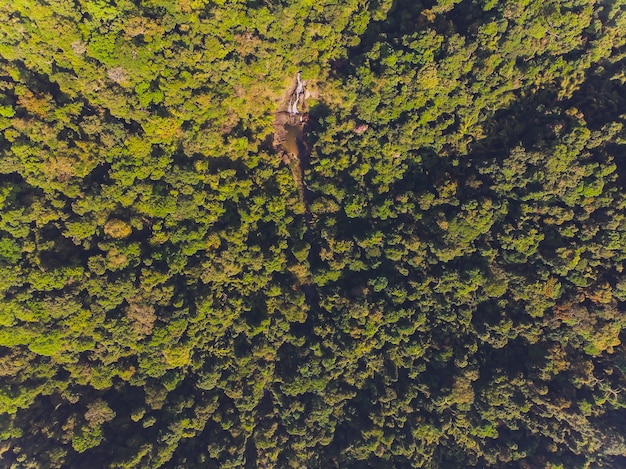Brazilian Cinema’s Green Shift: More Eco-Films by 2025?

Brazilian cinema is increasingly integrating environmental themes, with a noticeable rise in films addressing climate change and sustainability, reflecting a growing societal awareness and artistic commitment to ecological narratives by 2025.
In an era defined by urgent environmental concerns, the mirror of art often reflects societal shifts and anxieties. Within this context, the question arises: Is Brazilian Cinema and the Environment: Are More Films Addressing Climate Change and Sustainability in 2025? This exploration delves into how a nation rich in biodiversity is using its cinematic voice to tackle the planet’s most pressing issues.
The Evolution of Environmental Narratives in Brazilian Cinema
Brazilian cinema has a rich history of reflecting its social, political, and cultural landscapes. Historically, environmental themes surfaced often as metaphors or backdrops, rather than central plot points. However, a noticeable shift began to emerge in the late 20th and early 21st centuries, propelled by escalating global environmental awareness and local crises.
Filmmakers have started to move beyond merely depicting Brazil’s stunning natural beauty or the challenges of its remote regions. They are now actively engaging with the complexities of deforestation, pollution, indigenous rights tied to land, and the broader implications of climate change. This evolution suggests a maturing artistic response to a critical national and global issue.
Early Glimpses: Nature as a Setting
In its nascent stages, Brazilian cinema often showcased its diverse biomes, from the Amazon rainforest to the Pantanal wetlands. These depictions, while beautiful, rarely delved into the deep-seated environmental problems. Nature was a character, but not necessarily one in peril or the subject of an urgent message.
- “Barravento” (1962): Focused on the lives of fishermen in Bahia, subtly touching on their relationship with the sea, but not its degradation.
- “Deus e o Diabo na Terra do Sol” (1964): Explored the harsh realities of the Brazilian sertão, where the environment dictated survival, yet largely as a fixed, rather than threatened, entity.
- “Bye Bye Brasil” (1979): Showcased the vastness of the country, highlighting cultural shifts, with the environment as a scenic backdrop rather than a critical topic.
The Turning Tide: Initial Environmental Protests on Screen
As environmental movements gained traction globally in the 1980s and 90s, Brazilian filmmakers began to incorporate more explicit ecological concerns. Documentaries often led this charge, shedding light on specific issues and giving voice to affected communities.
- “Amazônia, Anavilhanas” (1987): An early example of documentary filmmaking directly addressing the Amazon’s ecological fragility.
- “Ilha das Flores” (1989): A dark satirical short, powerful in its critique of consumerism and waste, exposing environmental and social decay.
This period marked a transition from passive observation to active commentary, laying the groundwork for the more direct and urgent cinematic endeavors we see emerging today. The increasing visibility of environmental issues in public discourse naturally influenced artists, prompting them to explore these themes with greater depth and urgency.
The journey of environmental narratives in Brazilian cinema reflects a broader societal awakening. From breathtaking backdrops to central characters facing profound ecological challenges, the evolution is undeniable. This transformation positions cinema not just as entertainment, but as a crucial medium for public awareness and debate on climate change and sustainability.
Drivers of Change: What’s Pushing Environmental Films to the Forefront?
The surge in environmental films within Brazilian cinema is not accidental; it is driven by a confluence of factors, both internal and external. These elements create a fertile ground for storytellers to address climate change and sustainability with increasing urgency and nuance.
One primary driver is the undeniable reality of climate change impacts on Brazil. As a country with immense biodiversity and vulnerable ecosystems, from the Amazon rainforest to coastal regions, the effects of global warming are tangible. This direct experience often translates into a compelling need for artistic expression and public awareness, pushing filmmakers to explore these themes.
Global Awareness and Local Impacts
The global discourse on climate change, amplified by international agreements, scientific reports, and youth activism, profoundly influences local narratives. Brazilian filmmakers are responding to both universal calls to action and the specific, often devastating, local consequences of environmental degradation.
- Deforestation in the Amazon: Persisting high rates of deforestation create a constant visual and emotional impact, providing a grim backdrop for many narratives.
- Water Scarcity and Extreme Weather: Recurrent droughts in the Northeast and severe floods elsewhere highlight the direct challenges faced by communities, prompting cinematic reflection.
- Indigenous Land Rights: The ongoing struggle for indigenous populations to protect their ancestral lands and traditional ways of life often intertwines directly with environmental preservation, offering powerful human stories.
These local impacts provide authentic, urgent subject matter that resonates deeply with audiences, fostering a connection between the abstract concept of climate change and tangible human experiences.
Funding and Festivals: Nurturing Green Cinema
Support mechanisms, both national and international, play a crucial role in enabling the production of environmentally themed films. Government grants, although sometimes subject to political fluctuations, alongside private and non-profit funding, provide essential resources.
Furthermore, the proliferation of film festivals with dedicated environmental sections or entire festivals focused on ecological themes offers platforms for these films to gain visibility and recognition. Festivals like the CineEco – Festival Internacional de Cinema Ambiental da Serra da Estrela (Portugal, but with strong Brazilian presence due to thematic overlap) or local Brazilian environmental film showcases act as vital incubators and exhibition venues.
The recognition and awards these films receive further encourage more filmmakers to tackle environmental issues, creating a positive feedback loop within the industry.

Activism and Art: A Symbiotic Relationship
Many Brazilian filmmakers are not just artists; they are also activists. Their personal commitment to environmental causes often fuels their creative output. This blurring of lines between art and activism means that films are often conceived not just as entertainment, but as tools for social change and awareness.
Conversely, environmental movements increasingly recognize the power of cinema as a medium to reach broader audiences, spark dialogue, and mobilize public opinion. This symbiotic relationship strengthens the impact of both, making environmental films a potent force within the national discourse on sustainability.
These combined drivers suggest a sustained trajectory for environmental themes in Brazilian cinema. As the urgency of climate change intensifies, so too does the artistic imperative to respond, shaping a future where cinema plays an ever more significant role in environmental advocacy.
Key Themes and Approaches: What Stories Are Being Told?
The canvas of Brazilian environmental cinema is as diverse as its ecosystems, exploring a multitude of themes and employing varied narrative approaches. From the stark realities of deforestation to the subtle interplay of human connection with nature, these films are painting a complex picture of our environmental present and future.
One prominent theme revolves around the direct impacts of human activity on fragile ecosystems. Filmmakers are increasingly focusing on the destruction of the Amazon rainforest, not just as a global tragedy, but through the lens of local communities whose lives are intricately linked to its health. These stories often reveal the devastating consequences of logging, illegal mining, and agricultural expansion.
The Amazon: A Recurring Epicenter of Conflict and Beauty
The Amazon rainforest remains a central, often heart-wrenching, subject. Films explore the tension between development and preservation, often highlighting the voices of indigenous peoples and traditional communities who are on the front lines of environmental defense.
- Deforestation and Land Grabbing: Narratives frequently depict the relentless advance of the agricultural frontier, often leading to violent conflicts over land.
- Illegal Mining and Pollution: The devastating effects of gold mining, including river contamination and social disruption, are increasingly brought to screen.
- Indigenous Resilience: Many films celebrate the profound wisdom and enduring resistance of indigenous cultures as guardians of the forest, offering hope and alternative ways of living with nature.
These stories are not always easy to watch, but they are crucial for understanding the multifaceted challenges facing this vital biome and its inhabitants.
Urban Environmentalism and Pollution
Beyond the pristine, vanishing wilderness, Brazilian environmental cinema also grapples with urban ecological crises. Films explore themes of pollution, waste management, and the struggle for green spaces in densely populated cities. This approach broadens the scope of environmental discourse beyond remote natural areas, making it relevant to the everyday lives of urban dwellers.
The narratives often depict the health consequences of air and water pollution, the challenges of sustainable urban planning, and the potential for community-led initiatives to foster greener cities. This shift reflects a growing recognition that environmental issues are not just rural concerns, but affect everyone, everywhere.
Climate Change and its Broader Implications
While specific environmental issues form the backbone of many films, an increasing number are beginning to address the overarching theme of climate change directly. These narratives often explore the human cost of extreme weather events, the displacement of communities, and the psychological impact of living in an era of climate uncertainty.
The approaches can vary widely, from stark documentaries presenting scientific facts and testimonies to more metaphorical fictional works exploring humanity’s relationship with a rapidly changing planet. Some films even venture into speculative fiction, imagining possible futures shaped by environmental collapse or successful adaptation.
The diversity of themes and narrative approaches demonstrates the growing maturity and depth of environmental filmmaking in Brazil. By telling these varied stories, filmmakers are not only raising awareness but also challenging audiences to consider their own roles in the ongoing environmental crisis.
Future Projections: Will 2025 See an Upward Trend?
Projecting the future of Brazilian cinema’s engagement with environmental themes into 2025 involves considering several converging trends. While no one can predict with absolute certainty, the indicators suggest a continued, and likely accelerated, upward trend in the production of films addressing climate change and sustainability.
The increasing visibility and urgency of environmental issues globally, coupled with Brazil’s strategic position as a mega-biodiverse nation facing acute climate impacts, create a compelling impetus for filmmakers. It’s becoming increasingly difficult for artists to ignore these defining challenges of our time.
Increased Public and Political Pressure
Public awareness regarding climate change and environmental degradation is at an all-time high, both in Brazil and internationally. This heightened awareness translates into greater audience demand for content that educates, informs, and sparks dialogue on these crucial topics. As audiences become more conscious consumers of media, films with strong environmental messages will likely find a more receptive viewership.
Furthermore, while political landscapes can be volatile, environmental policies and international commitments, such as those from COP meetings, continue to exert pressure on governments and industries. This pressure can indirectly influence cultural production by fostering an environment where environmental concerns are prioritized, potentially leading to more funding opportunities for relevant film projects.
Technological Advancements and Accessibility
The democratization of filmmaking technology, from high-quality cameras on smartphones to accessible editing software, lowers the barrier to entry for aspiring filmmakers. This means more diverse voices, including those from environmental activists and affected communities, can tell their own stories without relying on traditional, expensive production models. This DIY approach can lead to raw, authentic, and urgent environmental narratives.
Additionally, the proliferation of streaming platforms (both global and local) provides unprecedented opportunities for distribution. Films that might have struggled to find theatrical release now have avenues to reach vast audiences, including those specifically interested in environmental content. This expanded reach encourages more niche, but impactful, environmental storytelling.

The Role of Generation Z and Younger Filmmakers
Generation Z and younger millennials are often characterized by their strong environmental consciousness and activism. As these generations increasingly enter the filmmaking industry, they are naturally bringing their values and concerns to their creative work. Their perspectives, often rooted in direct experience with climate anxiety and digital activism, are likely to infuse fresh energy and innovative approaches into environmental cinema.
These younger filmmakers are not just telling stories; they are actively shaping the narrative around climate change, ensuring it remains at the forefront of cultural conversation. Their innovative use of social media and short-form content can also amplify the message of feature films, creating a synergistic ecosystem of environmental media.
Given these strong drivers, it is highly probable that 2025 will indeed witness an acceleration in the production of Brazilian films addressing climate change and sustainability. The nation’s unique environmental challenges, coupled with global trends in awareness and technology, position its cinema to play an increasingly vital role in this critical dialogue.
Challenges and Opportunities for Green Brazilian Cinema
While the momentum for environmental films in Brazil is strong, the path forward is not without its hurdles. Understanding these challenges, alongside the emerging opportunities, is crucial for fostering the continued growth and impact of green Brazilian cinema.
One significant challenge lies in funding and economic stability. Film production, especially for projects tackling complex environmental issues that may not promise immediate commercial returns, heavily relies on consistent financial support. Fluctuations in government funding, coupled with a sometimes limited private investment pool, can make it difficult for filmmakers to secure the necessary resources for their projects.
Funding, Censorship, and Distribution Hurdles
Beyond the direct financial challenges, political shifts can introduce risks of censorship or a chilling effect on controversial environmental topics, particularly those that expose powerful vested interests. While freedom of expression is foundational, subtle pressures or a lack of support can deter filmmakers from tackling sensitive issues. Distribution, especially for independent environmental films, can also be a struggle, requiring innovative strategies to reach audiences beyond festival circuits.
- Economic Instability: Budget cuts to cultural agencies can directly impact film grants and public funding.
- Political Sensitivity: Films critical of specific industries or governmental actions related to the environment may face unofficial barriers.
- Market Niche: While growing, the audience for purely environmental films might still be considered niche by mainstream distributors.
Overcoming these hurdles requires a resilient and adaptive approach from filmmakers, leveraging international co-productions and alternative funding models.
Technological Advancements and Narrative Innovation
On the opportunity side, advancements in technology offer new avenues for documentary and narrative storytelling. Drone footage, virtual reality (VR), and augmented reality (AR) can immerse audiences in endangered environments like never before, creating powerful empathy and understanding. These tools can transcend traditional cinematic boundaries, offering unique perspectives on environmental issues.
Furthermore, there’s a growing appetite for narrative innovation. Beyond straightforward documentaries, fiction films that weave environmental themes into compelling human stories can reach broader audiences. Combining drama, suspense, or even romance with ecological messages can make these films more accessible and emotionally resonant, leading to a deeper impact.
The rise of digital platforms also presents a significant opportunity for wider distribution and audience engagement. Streaming services, often global in reach, can make Brazilian environmental films available to an international audience, potentially attracting more investment and amplifying their message on a global scale.
Collaborations and Education
Increased collaboration between filmmakers, environmental scientists, NGOs, and indigenous communities can enrich the authenticity and scientific accuracy of environmental narratives. Such partnerships can ensure that films are not only artistically compelling but also factually robust and culturally sensitive. This interdisciplinary approach can lead to more impactful storytelling and foster trust with audiences.
Lastly, the potential for film to serve as an educational tool is immense. Integrating environmental films into school curricula, public awareness campaigns, and community workshops can significantly contribute to environmental literacy and inspire action. The visual and emotional power of cinema can convey complex ecological concepts in ways that traditional educational materials often cannot.
While challenges persist, the opportunities for Brazilian green cinema to flourish are significant. By embracing innovation, fostering collaborations, and advocating for supportive policies, filmmakers can ensure their stories continue to play a vital role in addressing the global environmental crisis.
Notable Brazilian Environmental Films and Their Impact
Examining specific films provides tangible evidence of how Brazilian cinema is engaging with environmental themes, showcasing the diversity of approaches and their potential impact. These works not only entertain but also provoke thought, inspire action, and give voice to critical ecological concerns.
One of the most impactful categories includes documentaries that shine a spotlight on the Amazon. These films often combine investigative journalism with compelling visuals, exposing the realities of deforestation, illegal mining, and the struggles of indigenous communities.
“The Edge of Democracy” (2019) and Environmental Subplots
While primarily a political documentary, “The Edge of Democracy” by Petra Costa subtly weaves in the environmental impact of political decisions, particularly those affecting the Amazon. It highlights how policy shifts can have cascading effects on climate and natural resources. Although not exclusively an “environmental film,” its global reach brought a nuanced understanding of how interconnected politics and ecology are in Brazil.
Its impact lies in reaching a wide, international audience and demonstrating that environmental concerns are not isolated but deeply embedded in the political fabric of the nation. It showed how shifts in governance directly translate to consequences for the environment, especially the vital Amazon rainforest.
“The Territory” (2022): Indigenous Voices at the Forefront
“The Territory” (directed by Alex Pritz, produced by Darren Aronofsky, Sigrid Dyekjaer, Will N. Miller, Lizzie Gilmore, Gabriel Uchida, and Alex Pritz), is a powerful documentary focusing on the Uru-Eu-Wau-Wau people’s fight against illegal deforestation in the Amazon. What sets this film apart is its significant collaboration with the indigenous community, who not only feature prominently but also contributed to its filmmaking, including capturing some of the footage themselves.
- Direct Testimony: The film offers an intimate look at the daily lives and struggles of the Uru-Eu-Wau-Wau, providing firsthand accounts of their environmental defense efforts.
- Empowerment Through Film: By enabling indigenous participants to tell their own story, the film becomes a tool for self-representation and advocacy.
- Global Recognition: Its powerful narrative and production quality led to significant international acclaim, raising global awareness about indigenous land rights and Amazonian deforestation.
“The Territory” exemplifies a growing trend of films that prioritize indigenous perspectives, recognizing their deep connection to the land and their crucial role as environmental guardians. This empathetic approach resonates powerfully with audiences and policymakers alike.
“Bacurau” (2019): Dystopian Environmental Undertones
This acclaimed fictional film, directed by Kleber Mendonça Filho and Juliano Dornelles, is set in a remote Brazilian village that mysteriously disappears from maps. While primarily a socio-political thriller, “Bacurau” is steeped in environmental subtext, exploring themes of resource exploitation, neo-colonialism, and the resilience of communities against external threats.
The struggle of the villagers can be seen as a metaphor for communities fighting for their land and resources against powerful, often unseen, forces of degradation. Its fantastical elements highlight the absurdity and horror of environmental destruction and cultural erasure. Its popular appeal ensured that these themes reached a vast audience, sparking broader conversations about Brazil’s future.
These examples illustrate the varied and impactful ways Brazilian cinema is addressing the environment. From direct advocacy to allegorical narratives, filmmakers are leveraging their craft to illuminate the profound ecological challenges facing their nation and the world.
The Role of Brazilian Cinema in Shaping Public Opinion and Advocacy
Cinema, as a powerful expressive medium, holds a significant role in shaping public opinion and fostering advocacy for environmental causes. In Brazil, where environmental issues are often front-page news, films can transcend mere entertainment to become vital tools for education, awareness, and mobilization.
By bringing complex realities to the screen, often through deeply personal stories, films can humanize statistics and abstract concepts like “climate change.” They allow viewers to emotionally connect with the impacts of deforestation, pollution, and the struggle for sustainability, thereby fostering empathy and understanding.
Raising Awareness and Fostering Dialogue
Environmental films, whether documentaries or fictional narratives, play a crucial role in raising public awareness about specific ecological issues and their broader implications. They can expose hidden injustices, highlight scientific findings, and demonstrate the real-world consequences of unsustainable practices. This awareness is the first step towards informed public debate.
- Visual Storytelling: Cinema excels at presenting complex issues in an accessible, engaging, and emotionally resonant manner.
- Broader Reach: Films can reach audiences who may not actively seek out environmental news through other channels.
- Catalyst for Discussion: A well-made environmental film can spark conversations in homes, schools, and public forums, leading to deeper engagement with the topic.
This process of awareness-raising is fundamental for building a collective understanding of environmental challenges and potential solutions.
Inspiring Action and Mobilization
Beyond awareness, effective environmental films can inspire action. By showcasing grassroots movements, indigenous resistance, or successful conservation efforts, they can provide models for engagement and demonstrate that change is possible. This can empower individuals and communities to get involved in advocacy, activism, or sustainable practices in their own lives.
Many environmental films are specifically designed as advocacy pieces, created in collaboration with non-governmental organizations (NGOs) or activist groups. They are often used in educational campaigns, community screenings, and lobbying efforts to influence policy and promote specific agendas. The emotional impact of cinema can be a powerful motivator for behavioral change and political pressure.
Challenging Narratives and Promoting New Perspectives
Brazilian environmental cinema often challenges dominant narratives that prioritize economic growth over ecological preservation. By giving voice to marginalized communities, scientists, and activists, these films can present alternative perspectives on progress and development. They can highlight traditional ecological knowledge, sustainable living practices, and the intrinsic value of nature, fostering a more holistic understanding of our place within the environment.
This critical function is essential for a healthy democracy, allowing for diverse viewpoints to be heard and debated. By offering counter-narratives, cinema contributes to a more nuanced and robust public discourse on environmental governance and collective responsibility.
Ultimately, Brazilian cinema’s engagement with the environment is more than artistic expression; it is a vital contributor to the national and global environmental movement, playing a crucial role in shaping public opinion and advocating for a more sustainable future.
| Key Point | Brief Description |
|---|---|
| 🎬 Evolution of Themes | Brazilian cinema moved from scenic backdrops to direct engagement with environmental issues. |
| 📈 Increasing Trend | Driven by global awareness, local impacts, and youth activism, a surge in eco-films is expected by 2025. |
| 🌿 Key Narratives | Films focus on Amazon deforestation, indigenous rights, urban pollution, and broader climate change. |
| 📣 Shaping Opinion | Cinema serves as a powerful tool for public awareness, advocacy, and promoting sustainable perspectives. |
Frequently Asked Questions About Brazilian Cinema and the Environment
Brazil, home to vast natural resources like the Amazon, is acutely affected by climate change. Films reflect an urgent societal need to address deforestation, pollution, and sustainability, fostering awareness and dialogue about these critical local and global issues.
Brazilian environmental cinema tackles a range of issues including Amazon deforestation, illegal mining, water scarcity, urban pollution, and the struggles of indigenous populations defending their lands. Many also address the broader, interconnected themes of climate change and its human impact.
Yes, films like “The Territory” (2022) directly confront Amazon deforestation and indigenous rights. “Bacurau” (2019) uses dystopian elements to address resource exploitation. Even political documentaries like “The Edge of Democracy” (2019) subtly highlight environmental impacts of governance, influencing opinion.
They transform complex issues into accessible, emotional narratives, raising awareness and sparking discussions. Films can humanize struggles, challenge dominant narratives, and inspire audiences to engage in environmental advocacy, fostering a more informed and active citizenry.
A continued upward trend is anticipated due to increased public pressure, technological advancements lowering production barriers, new distribution channels like streaming, and the growing influence of environmentally conscious younger filmmakers. This confluence points to sustained growth and innovation.
Conclusion
As we navigate the complexities of 2025, the evidence strongly suggests that Brazilian cinema is not just observing but actively participating in the global conversation on climate change and sustainability. The increasing volume and quality of films addressing these critical issues reflect a profound cultural shift, driven by both the undeniable reality of environmental threats within Brazil and a growing artistic imperative to respond. From the storied Amazon to the bustling urban centers, Brazilian filmmakers are leveraging their craft to illuminate the challenges, celebrate resilience, and advocate for meaningful change. This evolving cinematic landscape indicates that film is not merely a reflection of society, but a powerful catalyst for shaping a more environmentally conscious future.





